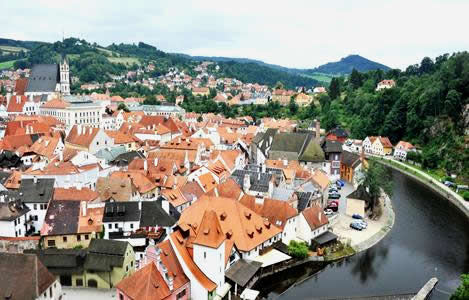|
Medieval Joy 
Photograph
by Preeti Verma Lal
"This is the Bone Church and it has the world’s most dazzling chandelier. Your jaws would drop. Your eyes would pop out. It is so unusual that you’d forget to kneel at the altar and mutter the prayers,” David Chlum, the guide, began solemnly in a hurried monologue. Outside the pint-sized grey church in Sedlec, a UNESCO World Heritage Site, I picked on my history lessons and let imagination run amok. The chandelier? Must be moulded in pure silver for I was not too far from Kutna Hora, the prosperous silver mining town. Or was the chandelier swathed in gold? Was it laced with silver medallions? Questions confounded me as Chlum smiled mysteriously and hopped down to the nave of the 13 th century church.
Yes, the chandelier was unusual. My jaws dropped. My eyes popped out. No, it was not made of silver. It was not swathed in gold. In the Bone Church , the chandelier was made of, well, bones. Human bones. There were bones everywhere – strung skulls hung in a corner, behind the iron bars lay a mound of bones, on the wall was the Schwarzenberg family’s coat of arms sedulously replicated with hundreds of bones, the arches festooned with skulls and in an alcove stood a ‘bony’ chalice. I winced while Chlum strayed to the beginning of the Bone Church – the abbot of Sedlec monastery returned from Palestine with a handful of soil and sprinkled it on the cemetery. Such was the draw of the holy soil that Sedlec became the most sought-after burial site in Central Europe . When the burials outgrew the space, bodies were exhumed and bones preserved in the church. The Bone Church contains the bones of nearly 40,000 dead. I stood petrified at the horrific tale and Chlum’s words rang true. Yes, I forgot to kneel at the altar and mutter my prayers.
In the Czech Republic , the beginnings were rather macabre, but I soon swapped the sinister bones for gleaming silver coins in Kutna Hora, where Bohemia ’s first Cistercian monastery was built in 1142. However, Kutna Hora’s fame lay not in piety but in piles of silver discovered in its mountainous belly in 1260. Soon, rapacious silver diggers and pushy Bohemian nobles trudged to the town that borrows its name from monks’ cowls. The royal mint added to the allure of the Kutna Hora, its prosperity and opulence just a few notches short of Prague . Nearly 2,000 tonnes of silver were shovelled out, but after three centuries the glory was snuffed by a massive flood, the blight of plague, the enormity of Thirty Years War and a devastating fire. The flourishing Kutna Hora was impoverished and the mines were abandoned by the end of 18 th century.
The Italian Courtyard that once resonated with the clamour of hammers of the royal mint now buzzes with the babel of curious tourists. All that remains of the mint are the ancient silver coins stashed under glass lids of stone pillars and a minter in velvet cloak who still stamps silver (it is actually aluminum) coins for delightful photo-ops. Tourists were jostling for a piece of history, harrying the minter for coins. I stood in a corner pitying the minter. No, I did not want the coin, I’d rather let the old man catch a breath. As I stepped out of the mint, I heard the jingle of a coin. Did the angels drop one from the heavens? No, it was Radka Neumannova of Czech Tourism Board. “Keep this for remembrance,” Neumannova gave me her freshly hammered coin.
“Brace yourself for the rapids. The brave shall row us to other end of Vltava river. It is a wooden raft, so muster all your energy”. The next morning in Cesky Krumlov began with Chlum’s instructions. But in the ritzy Hotel Ruze, I was distracted by the men in steel armour and black cowls standing still in the lobby. The 16 th century hotel was once a Jesuit University Monastery and the armour and spears look anomalous, but the air was redolent with the whiff of red roses and on the reception lay a bowl full of little candies.
The brave rafters had to wait for Chlum was herding us to the Cesky Krumlov Castle that peers out like a giant on the skyline of a squat town. Construction of the town and castle began in late 13 th century, most of its architecture taking cue from Gothic, Renaissance and Baroque styles. The walls are replete with beautiful oil paintings, on the dining table lie pewter decanters, the floors covered with exquisite carpets, dainty porcelain occupy nutwood shelves and marble stoves stand like sentinels in every room. However, nothing matches the beauty of the Baroque Theatre built in 1680-1682 under Prince Johann Christian I von Eggenberg. With original machinery, props and costumes, it is the best preserved Baroque theatre in the world. So fragile is the theatre that it is used only three times a year when a Baroque opera is performed under simulated candlelight. That day, however, the theatre’s extravagant stillness was broken by the sound of my stilettos. I felt guilty of intrusion and returned to the cobbled town square.
When the afternoon’s sunlit haze was elbowed out by fat raindrops of the evening, I retraced to the medieval times when men jousted and fenced and women danced the polka. I wriggled into a Doudlebsko (traditional costume), tossed a scarf over the shoulder, tied my long hair into a bun, fitted the tiara and got prepped for the lavish Czech meal. I dug my fork into the honey cake called Medovnik and got dreamy with the doleful chords of the hurdy gurdy.
I left behind the velvet costume and tiara in Cesky Krumlov. I returned home with the Kutna Hora coin. David Chlum’s funny stories. And Radka Neumannova’s kindness.
The Deccan Herald, 2011
|

